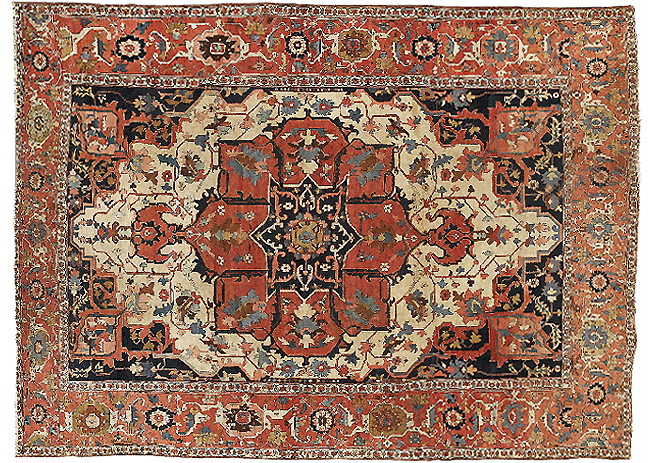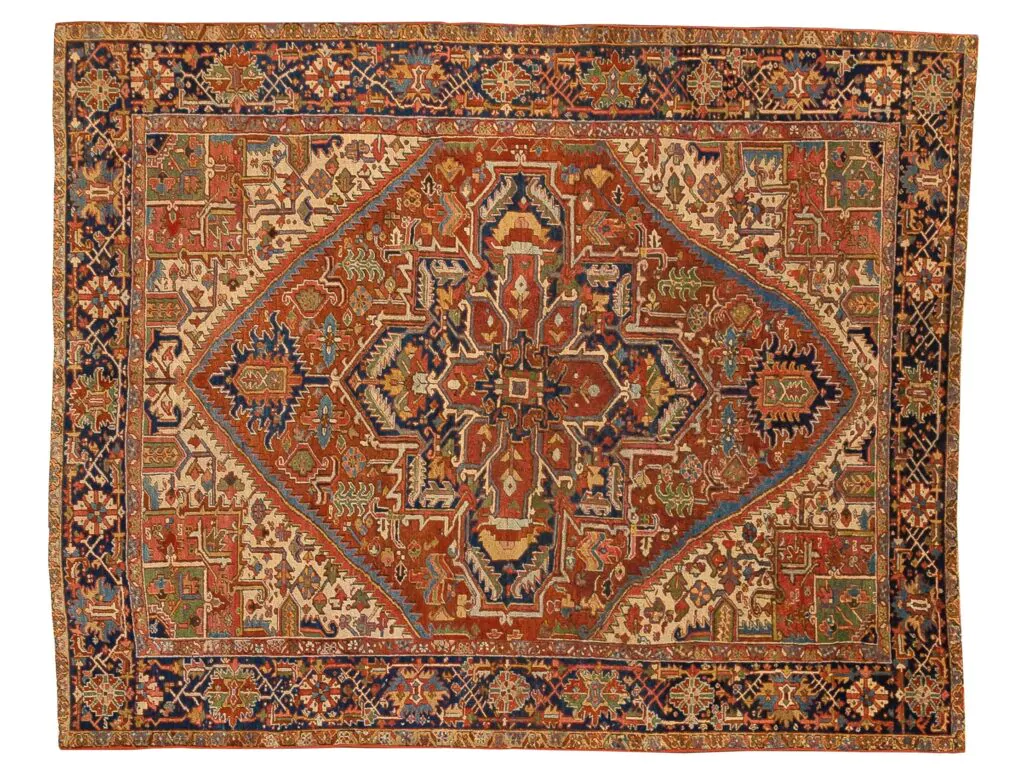Heriz
With distinctive large-scale motifs and a wide palette of warm colors, the ancient Heriz are probably the most popular rugs from this Persian region. In constant and growing demand over the last few decades, it has become scarce and has increased significantly in value and admiration.
These ancient Persian rugs are named after the largest city in a district with more than 30 villages, in the mountainous area of northwest Persia, 80 km east of Tabriz. The population is of Azeri origin and speak Turkic languages.
The creation of the classic Heriz “diamond square” medallion probably took place in the third part of the 19th century. The weavers of Heriz are credited with being the first in Persia to produce large size carpets with nomadic designs. It is believed that enterprising merchants from Tabriz, wanting room-sized Persian rugs for export, showed local weavers the city’s fine rugs and asked them to weave large rugs. The artists of Heriz, skilled in the most spontaneous and angular weaving of tribal origin, adapted these designs from ancient rugs. The result, is a wonderfully captivating hybrid, a rustic and charming rug from the villages but with the richness and grandeur of the Persian court.

Heriz carpets are known to be durable floor coverings. They have a cotton foundation and wool pile. Heriz weavers also made rugs with a silk foundation and silk pile. The symmetric knot is always employed.
The virtues of the antique Heriz rugs can be found in their design and color. The identity of a Heriz is its large medallion with large corners filled with angular oak leaves, while having a bold and captivating design. Some designs can be traced back to Anatolia motifs of the 17th century. The famous antique Serapi rugs from the same district tend to be more spacious in design, while Heriz rugs tend to be more densely designed. The designs include large stylized palmettes, leaves, and vines, with nomadic motifs and ornaments. Some carpets have an allover layout and others were woven with poetry inscriptions throughout the borders. Other more rarely seen shapes include designs of flowers or leaves and, occasionally, the “Tree of Life” motif reminiscent of some ancient Caucasian rugs.
Certainly, the ancient carpet makers of Heriz were consummate masters of vegetable dyeing. While Heriz rugs from the last 20-40 years are often chemically dyed, at best using a mixture of natural and chemical dyes, antique Heriz rugs were made with pure vegetable dyes. When they mature, they reach a wonderful patina. The technique of abrash, an intentional variation within a color tone, is used masterfully in the best antique rugs from Heriz. The well-developed technique of double or even triple delineation, which also distinguishes the best antique rugs from Heriz, creates remarkable strength and depth of color and design.

The best rugs in Heriz have the lustrous wool of the Shahsavan, nomads who reside in the vicinity of the Elbrus Mountains. Later on, the wool started to be imported from Tabriz. The wool was always of the highest quality and with high content of lanolin. The Heriz have a thick and resistant cotton base with well-compacted knots, making their durability well-known.
Many surrounding villages adopted the popular designs of Heriz in the last quarter of the 19th century. Generally, the weavings of these villages are grouped as Heriz carpets in the market, but each village is known individually by their names. The most popular villages are Ahar, Bilverdi, Sinsarai, and Bakhshaish. Although their designs were very similar to Heriz, all of them have their own characteristics, easily identifiable by their motifs, color, and quality.
In home design, Heriz rugs are loved for their versatility. Its geometry complements modern furniture and its warm colors and artistic depth enhance antiques of all kinds. Their rich color and design make them a popular choice for corporate environments as well. Heriz Persian rugs are an excellent investment due to their artistic uniqueness and appeal.

Figalli Oriental Rugs
We do not sell rugs. We bring rare works of art to your home in the form of rugs.
Our services
You are Protected
Copyright © 2023 Figalli Oriental Rugs, All rights reserved. Desenvolvido por Agência DLB – Agência de Marketing Digital em Porto Alegre


